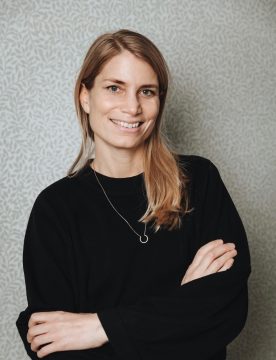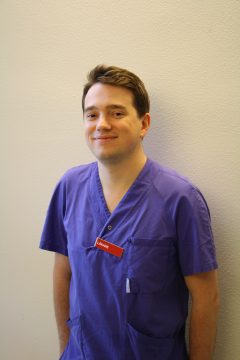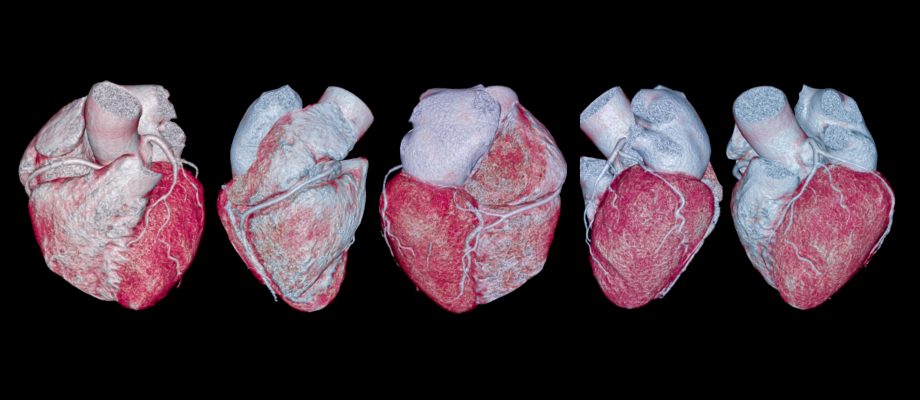DOCTORAL STUDIES. So far, two doctoral students at Sahlgrenska Academy have begun their doctoral studies in medical engineering in collaboration with Chalmers University of Technology. The thesis projects for both Eva Hagberg and Michael Kercsik concern developing assessment support based on artificial intelligence (AI) for different types of heart imaging.
Eva Hagberg’s thesis project deals with automated analysis of cardiac ultrasound readings. Ultrasound assessment, a common way to examine heart functions, requires extensive experience on the part of both the person taking the ultrasound images and the person assessing them.

“We utilize a special branch of artificial intelligence called Natural Language Processing, or NLP,” says Eva Hagberg. Eva is a resident physician in the Department of Clinical Physiology at Sahlgrenska University Hospital and a specialist in anesthesia and intensive care. “Based on opinions from the best experts in Gothenburg, we train a network, focusing on the assessment of the right chamber. We hope that, in the future, less experienced assessors of cardiac ultrasounds can approach the experts’ level of expertise using in-depth learning models.”
Joint problem solving
She looks forward to what she believes will be a very rewarding collaboration with doctoral students from Chalmers who, like her, are interested in using AI to process extensive and complicated data from the health care system:
“AI in echocardiography is a rapidly developing research area, and we believe the technology will be used in health care in the future. Medical doctors will need to have experience in it and be able to critically review the results. AI can be very useful in image sorting and comparison between examination episodes, which today takes a lot of time. AI is also good at pattern recognition and in the future can help predict disease, something we also want to work on in our research.”
She adds that working with the team is fun and that they have stimulating discussions when they try to solve a problem together: “I hope to learn some programming in the bargain.”
Hagberg’s thesis project is primarily based on large amounts of anonymized cardiac ultrasound data from Sahlgrenska University Hospital, but variation in the quality of both images and measurement data presents a challenge for the project.
“It is important to use not just healthy patients with perfect image quality in training AI networks, because then nothing else is learned. A challenging issue we are working on right now is ensuring consistency of our results with those from patient material from another hospital.”
Maximizing the information
In his thesis project, Michael Kercsik uses artificial intelligence to find new, previously unknown connections in computed tomographic images of the coronary arteries, which can improve the diagnosis of chronic coronary artery disease.

“Computed tomographic angiography of the coronary arteries has recently played a larger role in the clinical diagnosis of chronic coronary artery disease, and we hypothesize that there is more information in the images than the human eye can discern,” says Kercsik, who also works clinically as a resident physician in radiology at Sahlgrenska University Hospital.
Bringing together his favorite subjects
The project uses material from SCAPIS, the Swedish CArdioPulmonary bioImage Study, with 30,000 randomly selected Swedes between ages 50 and 64 who have undergone extensive examinations of the heart and lungs. Combined with all the clinical, laboratory, and genetic data collected in the study, Kercsik believes that there are good opportunities for new exciting discoveries.
Since both biology and technology have long been his favorite subjects, he now looks forward to bringing together his personally interest at a professional level.
“The way of thinking and terminology in mathematics and computer science is different compared to medicine, which I find challenging. But the continual professional development that this requires is enormously gratifying, and it offers many new ideas and perspectives on how to solve a problem,” says Kercsik.
“I believe that a joint graduate school provides good preparation and good opportunities to participate in the continued development of ground-breaking medical technology. I strongly believe that both the medical and technical fields have much to gain from increased interdisciplinary collaboration.”
BY: ELIN LINDSTRÖM











